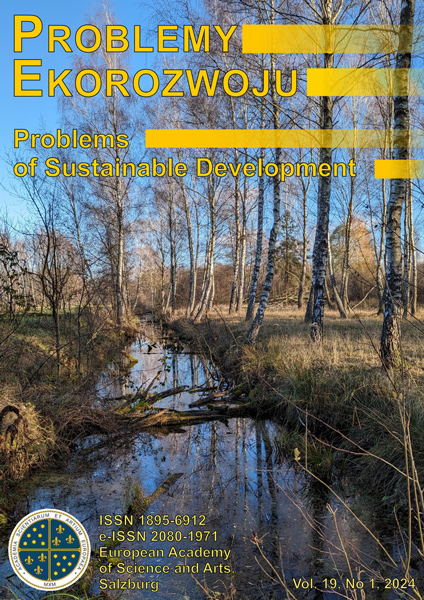AHMED A.A., NAZZAL M.A., DARRAS B.M., 2022, Cyber-Physical Systems as an Enabler of Circular Economy to Achieve Sustainable Development Goals: A Comprehensive Review. International Journal of Precision Engineering and Manufacturing-Green Technology, 9: 955–975.
DOI: https://doi.org/10.1007/s40684-021-00398-5
ALI E.B., ANUFRIEV V.P., AMFO B., 2021, Green economy implementation in Ghana as a road map for a sustainable development drive: A review, Scientific African, 2: e00756.
DOI: https://doi.org/10.1016/j.sciaf.2021.e00756
AVTAR R., AGGARWAL R., KHARRAZI A., KUMAR P., KURNIAWAN T.A., 2019, Utilizing geospatial information to implement SDGs and monitor their Progress, Environmental monitoring and assessment, 192(35), https://www.doi.org/10.1007/s10661-019-7996-9.
DOI: https://doi.org/10.1007/s10661-019-7996-9
BARCELLOS-PAULA L., DE LA VEGA I., GIL-LAFUENTE A.M., 2021, The Quintuple Helix of Innovation Model and the SDGs: Latin-American Countries’ Case and Its Forgotten Effects, Mathematics, 9(4): 416.
DOI: https://doi.org/10.3390/math9040416
CARAYANNIS E.G., BARTH T.D., CAMPBELL D.F., 2012, The Quintuple Helix innovation model: Global warming as a challenge and driver for innovation. Journal of Innovation and Entrepreneurship, 1(2): 1-12.
DOI: https://doi.org/10.1186/2192-5372-1-2
CHAABEN N., ELLEUCH Z., HAMDI B., KAHOULI B., 2022, Green economy performance and sustainable development achievement: empirical evidence from Saudi Arabia, Environment, Development and Sustainability, https://www.doi.org/10.1007/s10668-022-02722-8.
DOI: https://doi.org/10.1007/s10668-022-02722-8
ĐORIĆ Ž., 2021, Green economy and sustainable development in the Western Balkan countries, Ekonomske ideje i praksa [Economic ideas and practice], 41: 67-91.
EVANS J.D., 1996, Straightforward statistics for the behavioral sciences, Thomson Brooks/Cole Publishing Co.
GIBBONS M., LIMOGES C., NOWOTNY H., 1994, The New Production of Knowledge: The Dynamics of Science and Research in Contemporary Societies, SAGE Publications Ltd.
GRUNDEL I., DAHLSTRÖM M., 2016, A Quadruple and Quintuple Helix Approach to Regional Innovation Systems in the Transformation to a Forestry-Based Bioeconomy, Journal of the Knowledge Economy, 7: 963–983.
DOI: https://doi.org/10.1007/s13132-016-0411-7
ILIĆ B., 2020, Social Component of Sustainable Development and Quality of Life: Region of the Balkans, Eastern Serbia, Handbook of Research on Creating Sustainable Value in the Global Economy, ed. Akkucuk U., IGI Global: 452-462.
DOI: https://doi.org/10.4018/978-1-7998-1196-1.ch026
ILIĆ B., STOJANOVIC D., DJUKIC G., 2019, Green economy: mobilization of international capital for financing projects of renewable energy sources, Green Finance, 1(2): 94-109.
DOI: https://doi.org/10.3934/GF.2019.2.94
JAFARZADEGAN M., SAFI-ESFAHANI F., BEHESHTI Z., 2019, Combining hierarchical clustering approaches using the PCA method, Expert System with Applications, 137: 1–10.
DOI: https://doi.org/10.1016/j.eswa.2019.06.064
JIN X., 2012, Guang Yuan Low-carbon Development Path Based on SWOT Analysis, Journal of Sustainable Development, 5(8): 78-83.
DOI: https://doi.org/10.5539/jsd.v5n8p78
KÖNIG J., SUWALA L., DELARG, C., 2021, Helix Models of Innovation and Sustainable Development Goals, Industry, Innovation and Infrastructure. Encyclopedia of the UN Sustainable Development Goals, eds. Leal Filho W., Azul A.M., Brandli L., Lange Salvia A., Wall T., Springer, Cham: 1-15.
DOI: https://doi.org/10.1007/978-3-319-71059-4_91-1
LAFORTUNE G., FULLER G., SCHMIDT-TRAUB G., KROLL C., 2020, How Is Progress towards the Sustainable Development Goals Measured? Comparing Four Approaches for the EU, Sustainability, 12(18): 7675.
DOI: https://doi.org/10.3390/su12187675
LAVRINENKO O., IGNATJEVA S., OHOTINA A., RYBALKIN O., LAZDANS D., 2019, The Role of Green Economy in Sustainable Development (Case Study: The EUStates), Entrepreneurship and Sustainability Issues, 6(3): 1113-1126.
DOI: https://doi.org/10.9770/jesi.2019.6.3(4)
ŁĄCKA I., 2020, Barriers to Using of Quintuple Helix Model to Create Innovations in Polish Regions, Scientific Papers of Silesian University of Technology, Organization and Management Series No 146, Silesian University of Technology Publishing House: 233-251.
DOI: https://doi.org/10.29119/1641-3466.2020.146.18
MILLARD J., 2018, How social innovation underpins sustainable development, Atlas of Social Innovation: New Practices for a Better Future, ed. Howaldt, J., Kaletka, C., Schröder, A., Zirngiebl, M., SI-DRIVE: 41-43.
MIOLA A., SCHILTZ F., 2019, Measuring sustainable development goals performance: How to monitor policy action in the 2030 Agenda implementation? Ecological economics: The Journal of the International Society for Ecological Economics, 164: 106373.
DOI: https://doi.org/10.1016/j.ecolecon.2019.106373
NAIDOO D., NHAMO L., LOTTERING S., MPANDELI S., LIPHADZI S., MODI A. T., TROIS C., MABHAUDHI T., 2021, Transitional Pathways towards Achieving a Circular Economy in the Water, Energy, and Food Sectors, Sustainability, 13(17): 9978.
DOI: https://doi.org/10.3390/su13179978
OSPANOVA A., POPOVYCHENKO I., CHUPRINA E., 2022, Green Economy – Vector of Sustainable Development, Problemy Ekorozwoju/ Problems of Sustainable Development, 17(1): 171-181.
DOI: https://doi.org/10.35784/pe.2022.1.16
PRASAD A., LOUKOIANOVA E., XIAOCHEN FENG A., OMAN W., 2022, Mobilizing Private Climate Financing in Emerging Market and Developing Economies, Staff Climate Notes, 2022(007), International Monetary Fund.
DOI: https://doi.org/10.5089/9798400216428.066
QUACOE D., KONG Y., QUACOE D., 2023, Analysis of How Green Growth and Entrepreneurship Affect Sustainable Development: Application of the Quintuple Helix Innovation Model in the African Context, Sustainability, 15: 907.
DOI: https://doi.org/10.3390/su15020907
RYBALKIN O., 2022, Sustainable development goals progress in the European Union: correlation with EEPSE green economy index, Access to science, business, innovation in digital economy, ACCESS Press, 3(2): 121-135.
DOI: https://doi.org/10.46656/access.2022.3.2(3)
RYBALKIN O., LAVRINENKO O., IGNATJEVA S., DANILEVICA A., 2021, Introduction of EEPSE Green Economy Index for the analysis of regional trends. Entrepreneurship and Sustainability Issues, 9(1): 415-435.
DOI: https://doi.org/10.9770/jesi.2021.9.1(26)
RYSZAWSKA B., 2015, Towards a green economy. From ideas to practice, ed. Burchard-Dziubińska, M., Chapter: Green Economy Indicators, Wydawnictwo Uniwersytetu Łódzkiego, Łódź, Poland: 31-52.
SWART J., GROOT L., 2020, Sustainable development: The transition to the green economy, Quality - Access to Success, 15(SUPPL.1): 129-133.
TADASHI H., 2022, A balancing act between economic growth and sustainable development: Historical trajectory through the lens of development indicators. Sustainable Development, 30(6): 1900-1910.
DOI: https://doi.org/10.1002/sd.2357
UNITED NATIONS, 2015, Transforming our world: the 2030 Agenda for Sustainable development, New York/
UNSTAT, 2022, Global indicator framework for the Sustainable Development Goals and targets of the 2030 Agenda for Sustainable Development,
https://unstats.un.org/sdgs/indicators/Global%20Indicator%20Framework%20after%202022%20refinement_Eng.pdf (April 28, 2023).
VENKATESH G., 2021, Sustainable Development Goals – Quo Vadis, Cities of the World? Problemy Ekorozwoju/Problems of Sustainable Development, 16(1): 171-179.
DOI: https://doi.org/10.35784/pe.2021.1.18
VERTAKOVA Y., PLOTNIKOV V., 2017, Problems of sustainable development worldwide and public policies for green economy, Economic Annals-XXI, 166(7–8): 4-10.
DOI: https://doi.org/10.21003/ea.V166-01
ZHAO L., HE W., WANG A., ZHU F., 2023, Time and Frequency Spillovers between the Green Economy and Traditional Energy Markets, Systems, 11(3): 153.
DOI: https://doi.org/10.3390/systems11030153
ZHIRONKIN S., CEHLÁR M., 2022, Green Economy and Sustainable Development: The Outlook, Energies, 15(3): 1167.
DOI: https://doi.org/10.3390/en15031167







